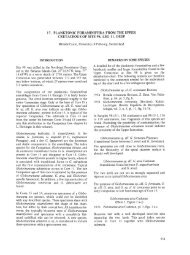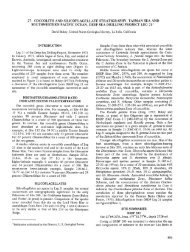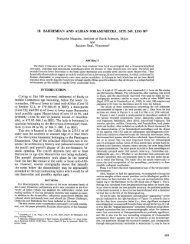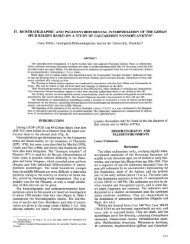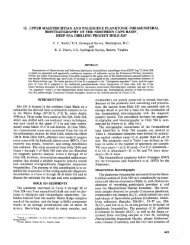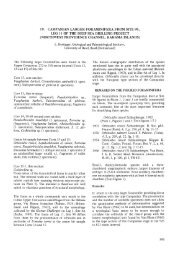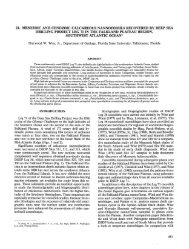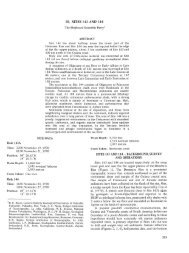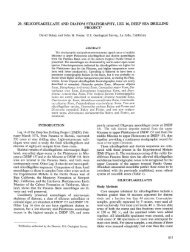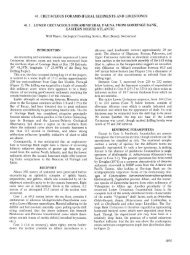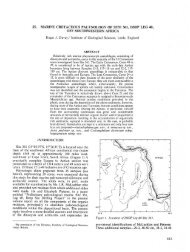16. Radiolaria - Deep Sea Drilling Project
16. Radiolaria - Deep Sea Drilling Project
16. Radiolaria - Deep Sea Drilling Project
You also want an ePaper? Increase the reach of your titles
YUMPU automatically turns print PDFs into web optimized ePapers that Google loves.
M. G. PETRUSHEVSKAYA, G. E. KOZLOVA<br />
lEucyrtidium euporum Ehrenberg, 1872a, p. 291; 1872b, pi. 4, fig.<br />
20; Petrushevskaya, 1967, p. 141, pi. 80, figs. 1-4.<br />
Dictyomitra drigalskii Popofsky, 1908, p. 293, pi. 36, fig. 4.<br />
ILithomitra bramlettei Clark and Campbell, 1944, p. 53, pi. 7, fig.<br />
11, part.<br />
Artostrobium auritum (Ehrenberg) group, Riedel and Sanfilippo, in<br />
press, pi. 1H, fig. 8, part.<br />
The broadest segment is the fourth (cephalis being the first). The<br />
greatest breadth of the fourth segment is up to 60-70µ.<br />
Differs from the closely related Botryostrobus {=Lithostrobus)<br />
botryocyrtis (Haeckel, 1887), see Riedel and Sanfilippo, in press, pi.<br />
1H, fig. 6, by more slender, elongated skeleton.<br />
Miocene-Recent.<br />
Genus SPIROCYRTIS Haeckel<br />
Spirocyrtis Haeckel, 1887, p. 1508; Campbell, 1954, p. 142,<br />
Petrushevskaya, 1971b, p. 236. = Spirocyrtidium Haeckel, 1887,<br />
p. 1509. Type species Spirocyrtis scalaris Haeckel (1887, pi. 76,<br />
fig. 14).<br />
Very much the same as Botryostrobus. Differs by the difference<br />
in the thickness of the thoracic wall and that of the post-thoracic<br />
segments, pores being smaller on them than on the thorax. The<br />
length of the post-thoracic segments is not so definite as it is in<br />
Botryostrobus species.<br />
Neogene-Recent.<br />
Spirocyrtis subtilis Petrushevskaya sp. nov.<br />
(Plate 24, Figures 22-24)<br />
Spirocyrtis sp. aff. S. scalaris, Riedel and Sanfilippo, in press, pi. 1G,<br />
fig. 24; pi. 2H, figs. 15, 17, 18, pi. 3E, fig. 2, part.<br />
Artostrobium sp. B, Petrushevskaya, 1971b, pi. 124, figs. 4-5.<br />
The narrowest post-thoracic segment—the third—is about 45µ<br />
broad. The broadest segment—the seventh or the eighth—about<br />
70-80µ broad. The outline of the test is variable. The length of a<br />
post-thoracic segment is variable also. Very often there is a tube,<br />
connected with the spine A<br />
Description is based on thirteen specimens from 139-5-CC,<br />
140-2-1, 5-7 cm and 140-2-4, 80-82 cm.<br />
'Subtilis' —Latin adjective meaning "slender".<br />
Miocene.<br />
Spirocyrtis sp.<br />
(Plate 24, Figures 27, 28)<br />
The species is distinguished from S. scalaris by its rounded, not<br />
angular segments—the outline of the test is festooned, not step-like<br />
as it is in S. scalaris.<br />
This species differs from the Botryostrobus species referred to<br />
by Riedel and Sanfilippo as Spirocyrtis sp. aff. S. scalaris (in press,<br />
pi. 1G, figs. 19, 20, 22) by the skeleton being broader distally, and<br />
having more segments.<br />
Quaternary.<br />
Spirocyrtis cornutella Haeckel<br />
(Plate 24, Figure 26)<br />
Spirocyrtis cornutella Haeckel, 1887, p. 1509, pi. 76, fig. 13;<br />
Petrushevskaya, 1971c.<br />
Spirocyrtis scalaris Hck., Riedel and Sanfilippo, in press, pi. 1G, fig.<br />
26, part.<br />
This species is distinguished from S. scalaris by the irregular<br />
outline and narrower skeleton. It is similar in these features to S.<br />
subtilis but in S. cornutella the skeleton is shorter, and there is no<br />
tube connected with the spinel.<br />
Pliocene?-Quaternary.<br />
Family NEOSCIADIOCAPSIDAE Pessagno<br />
Neosciadiocapsidae Pessagno, 1969, p. 392.<br />
Spines A, D, Vert, Axial, two L and two 1 are going from MB in<br />
the same way as in all typical Eucyrtidioidea. Cephalis hemispherical<br />
to conical, imperforate or perforate, with or without horns. The<br />
eucephalic part of the cephalis is confused with the other parts, and<br />
there exists one cavity of the cephalis unseparated into lobes.<br />
Arches ap go in the upper part of the cephalic wall (the same as in<br />
Eribotrys described by Foreman, 1968)—see Petrushevskaya (1968a,<br />
fig. 5 IV-IX). Tube ("cephalopyle", Pessagno, 1969) may be<br />
present, connected with the spine Vert. Poorly developed or<br />
540<br />
pronounced collar stricture. Thorax conical to cylindrical in shape<br />
proximally, flaring to form a narrow to broad thoracic shirt (a<br />
velum) distally. Thoracic pores variable in size are situated in<br />
transverse (concentric) rows. Mouth may be closed by planiform to<br />
conical plate.<br />
Cretaceous-Recent.<br />
Genus PETASSIFORMA Pessagno<br />
Petassiforma Pessagno, 1969, p. 411. Type species Petassiforma<br />
foremanae Pessagno, 1969, pi. 23, figs. 6-1-0, pi. 24, fig. 2.<br />
Petassiforma speciosa (Squinabol)<br />
(Plate 7, Figure 21)<br />
Sethoconus speciosus Squinabol, 1904, p. 131, pi. 8, fig. <strong>16.</strong><br />
The dimensions of the skeleton are nearly the same as in P.<br />
formanae Pessagno.<br />
Cretaceous (Maestrichtian).<br />
Genus EUCECRYPHALUS Haeckel<br />
Eucecryphalus Haeckel, 1860, p. 836; 1881, p. 431; 1887, p. 1220;<br />
Campbell, 1954, p. 122; Petrushevskaya, 1972b, p. 222, part. =<br />
Eucecryphalium Haeckel, 1887, p. 1221; Campbell, 1954, p.<br />
122. Type species Eucecryphalus gegenbauri Haeckel, 1862, pi.<br />
5, figs. 12-15.<br />
Eucecryphalus sp.<br />
(Plate 33, Figures 6,7,8)<br />
Two divergent horns on the cephalis. The upper part (about<br />
20-30µ long) of the thorax has small pores. Then, after a<br />
constriction, comes the middle part-conical, with larger pores. It is<br />
about 70µ long and up to 100-1 lOµ broad. The thoracic velum has 3<br />
to 4 rows of pores. The latter are smaller than the pores on the<br />
middle part of the thorax. This species is very similar tc Cassideus<br />
yoloensis Pessagno 1969, pi. 26, figs. 1-3, in the outline of the shell.<br />
It differs from C. yoloensis by its smaller pores on the thorax and<br />
by its smaller velum.<br />
Quaternary.<br />
Genus CLATHROCYCLAS Haeckel<br />
Clathrocyclas Haeckel, 1888, p. 434; 1887, p. 1385; Campbell,<br />
1954, p. 132; Foreman, 1968, p. 46. Type species Clathrocyclas<br />
vrincipessa Haeckel, 1887, pi. 74, fig. 7.<br />
Characteristic for this genus is the roomy, bulbous thorax, nearly<br />
cylindrical in its lower part. In Petassiforma and in Eucecryphalus it<br />
is slender, high-conical. In Clathrocyclas, pores on the thorax are<br />
rather large, not numerous. The cephalis is up to 28-38µ broad.<br />
Vertical spines form tube or horn (Petrushevskaya, 1971b, pi. 115,<br />
fig. 2).<br />
Cretaceous-Recent.<br />
Clathrocyclas bicornis (Popofsky)<br />
(Plate 33, Figures 11, 12)<br />
Pterocorys bicornis Popofsky, 1908, p. 228, pi. 34, figs. 7, 8.<br />
Theocalyptra bicornis (Popofsky) Riedel, 1958, p. 240, pi. 4, fig. 4;<br />
Petrushevskaya, 1967, p. 126, pi. 71, figs. 2, 7, part, non<br />
Clathrocyclas bicornis Hays, 1965.<br />
The latter species must have another name, "bicornis" being<br />
preoccupied in this genus. If J. Hays has nothing against it, as a<br />
name for his species "antebicornis" may be suggested.<br />
Pliocene-Recent-C bicornis.<br />
Miocene-Pliocene—C. antebicornis.<br />
Genus DIPLOCYCLAS Haeckel<br />
Diplocyclas Haeckel, 1881, p. 434; 1887, p. 1392; Campbell, 1954,<br />
p. 132. Type species Diplocyclas bicorona Haeckel, 1887, pi. 59,<br />
fig. 8.<br />
Thorax high, conical, nearly cylindrical, often irregular in<br />
outline. As a rule, the test is smaller than in Clathrocyclas. Pores on<br />
the thorax rather large, not numerous. The species Theocalyptra<br />
davisiana (Ehrenberg). described by Riedel, 1958, p. 239, pi. 4, figs.<br />
2, 3 and by Petrushevskaya, 1967, p. 122, pi. 69, figs. 1-7, seems to<br />
belong in this genus.<br />
Diplocyclas sp a ff D bicorona Haeckel<br />
(Plate 33, Figures 17,18)<br />
"(Diplocyclas bicorona Haeckel, 1887, pi. 59, fig. 8.



